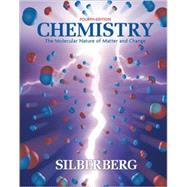
What is included with this book?
| Chemistry: The Molecular Nature of Matter and Change | |
| Keys to the Study of Chemistry | |
| Some Fundamental Definitions | |
| The Properties of Matter | |
| The Three States of Matter | |
| The Central Theme in Chemistry | |
| The Importance of Energy in the Study of Matter | |
| Chemical Arts and the Origins of Modern Chemistry Prechemical Traditions | |
| The Phlogiston Fiasco and the Impact of Lavoisier | |
| The Scientific Approach: Developing a Model | |
| Chemical Problem Solving Units and Conversion Factors in Calculations | |
| A Systematic Approach to Solving Chemistry Problems | |
| Measurement in Scientific Study General Features of SI Units Some Important SI Units in Chemistry | |
| Uncertainty in Measurement: Significant Figures Determining Which Digits Are Significant Working with Significant Figures in Calculations Precision, Accuracy, and Instrument Calibration Chapter Perspective Chemical Connections to Interdisciplinary Science: Chemistry Problem Solving in the Real World For Review and Reference Problems | |
| The Components of Matter | |
| Elements, Compounds, and Mixtures: An Atomic Overview | |
| The Observations That Led to an Atomic View of Matter | |
| Dalton's Atomic Theory Postulates of the Atomic Theory How the Theory Explains the Mass Laws | |
| The Relative Masses of Atoms | |
| The Observations That Led to the Nuclear Atom Model Discovery of the Electron and Its Properties Discovery of the Atomic Nucleus | |
| The Atomic Theory Today Structure of the Atom Atomic Number, Mass Number, and Atomic Symbol Isotopes and Atomic Masses of the Elements Tools of the Laboratory: Mass Spectrometry A Modern Reassessment of the Atomic Theory | |
| Elements: A First Look at the Periodic Table | |
| Compounds: Introduction to Bonding | |
| The Formation of Ionic Compounds | |
| The Formation of Covalent Compounds | |
| The Elements of Life | |
| Compounds: Formulas, Names, and Masses Types of Chemical Formulas Some Advice about Learning Names and Formulas Names and Formulas of Ionic Compounds Names and Formulas of Binary Covalent Compounds An Introduction to Naming Organic Compounds Molecular Masses from Chemical Formulas Gallery: Picturing Molecules | |
| Mixtures: Classification and Separation Tools of the Laboratory: Basic Separation Techniques Chapter Perspective For Review and Reference Problems | |
| Stoichiometry of Formulas and Equations | |
| The Mole Defining the Mole Molar Mass Interconverting Moles, Mass, and Number of Chemical Entities Mass Percent from the Chemical Formula | |
| Determining the Formula of an Unknown Compound Empirical Formulas Molecular Formulas Chemical Formulas and Molecular Structures | |
| Writing and Balancing Chemical Equations | |
| Calculating Amounts of Reactant and Product Stoichiometrically Equivalent Molar Ratios from the Balanced Equation Chemical Reactions That Occur in a Sequence Chemical Reactions That Involve a Limiting Reactant Chemical Reactions in Practice: Theoretical, Actual, and Percent Yields | |
| Fundamentals of Solution Stoichiometry Expressing Concentration in Terms of Molarity Mole-Mass-Number Conversions Involving Solutions Preparing and Diluting Molar Solutions Stoichiometry of Chemical Reactions in Solution Chapter Perspective For Review and Reference Problems | |
| The Major Classes of Chemical Reactions | |
| The Role | |
| Table of Contents provided by Publisher. All Rights Reserved. |
The New copy of this book will include any supplemental materials advertised. Please check the title of the book to determine if it should include any access cards, study guides, lab manuals, CDs, etc.
The Used, Rental and eBook copies of this book are not guaranteed to include any supplemental materials. Typically, only the book itself is included. This is true even if the title states it includes any access cards, study guides, lab manuals, CDs, etc.